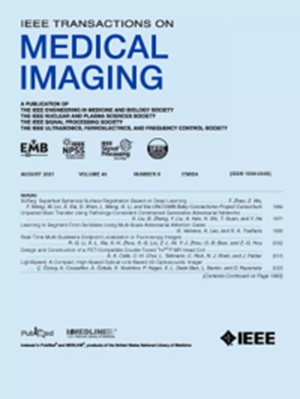A Wasserstein Space Based Framework for Processing Fiber Orientation Geometry in Diffusion MRI.
IF 9.8
1区 医学
Q1 COMPUTER SCIENCE, INTERDISCIPLINARY APPLICATIONS
引用次数: 0
Abstract
The fiber orientation distribution (FOD) function is an advanced model for high angular resolution diffusion MRI, capable of representing complex crossing or fanning fiber geometries. However, the intricate mathematical structures of FOD functions pose significant challenges for data processing and analysis. Current frameworks often fail to consider fiber bundle rotation information among FOD peaks, leading to improper data processing, such as inaccurate FOD interpolation and, consequently, anatomically incorrect fiber tracking. This paper presents a novel Wasserstein space based framework for processing and analyzing FOD functions that systematically considers fiber-bundle-specific geometry. Our approach begins with a spherical deconvolution method to accurately detect and decompose FOD functions into single-peak lobes. These single-peak lobes are then embedded into the Wasserstein space, where a new metric for FOD functions is defined, capable of handling rotations among peak lobes. We introduce a geometry-aware clustering method to regroup the single-peak lobes for further bundle-specific FOD processing. The proposed framework is applied to the essential task of FOD interpolation, computed as the Barycenter of the new metric, with a fast approximation method for efficient computation. Experiments conducted on synthetic data, as well as datasets from the Human Connectome Project (HCP) and the Alzheimer's Disease Neuroimaging Initiative (ADNI), demonstrate that our framework effectively handles complex fiber geometries, provides anatomically meaningful FOD interpolations, and significantly enhances the performance of FOD-based tractography.弥散MRI中纤维取向几何处理的Wasserstein空间框架。
纤维取向分布(FOD)函数是高角分辨率扩散MRI的先进模型,能够表示复杂的交叉或扇形纤维几何形状。然而,FOD函数复杂的数学结构给数据处理和分析带来了巨大的挑战。目前的框架往往没有考虑到FOD峰之间的纤维束旋转信息,导致数据处理不当,例如不准确的FOD插值,从而导致解剖学上不正确的纤维跟踪。本文提出了一种新的基于Wasserstein空间的FOD函数处理和分析框架,该框架系统地考虑了纤维束特定的几何形状。我们的方法首先采用球面反褶积方法来准确地检测FOD函数并将其分解为单峰瓣。然后将这些单峰叶嵌入到Wasserstein空间中,在该空间中定义了FOD函数的新度量,能够处理峰叶之间的旋转。我们引入了一种几何感知的聚类方法来重组单峰瓣,以便进一步进行特定束的FOD处理。将该框架应用于FOD插值的核心任务,以新度量的质心计算,并采用快速逼近方法提高计算效率。在合成数据以及来自人类连接组计划(HCP)和阿尔茨海默病神经成像计划(ADNI)的数据集上进行的实验表明,我们的框架有效地处理了复杂的纤维几何形状,提供了具有解剖学意义的FOD插值,并显著提高了基于FOD的神经束成像的性能。
本文章由计算机程序翻译,如有差异,请以英文原文为准。
求助全文
约1分钟内获得全文
求助全文
来源期刊

IEEE Transactions on Medical Imaging
医学-成像科学与照相技术
CiteScore
21.80
自引率
5.70%
发文量
637
审稿时长
5.6 months
期刊介绍:
The IEEE Transactions on Medical Imaging (T-MI) is a journal that welcomes the submission of manuscripts focusing on various aspects of medical imaging. The journal encourages the exploration of body structure, morphology, and function through different imaging techniques, including ultrasound, X-rays, magnetic resonance, radionuclides, microwaves, and optical methods. It also promotes contributions related to cell and molecular imaging, as well as all forms of microscopy.
T-MI publishes original research papers that cover a wide range of topics, including but not limited to novel acquisition techniques, medical image processing and analysis, visualization and performance, pattern recognition, machine learning, and other related methods. The journal particularly encourages highly technical studies that offer new perspectives. By emphasizing the unification of medicine, biology, and imaging, T-MI seeks to bridge the gap between instrumentation, hardware, software, mathematics, physics, biology, and medicine by introducing new analysis methods.
While the journal welcomes strong application papers that describe novel methods, it directs papers that focus solely on important applications using medically adopted or well-established methods without significant innovation in methodology to other journals. T-MI is indexed in Pubmed® and Medline®, which are products of the United States National Library of Medicine.
 求助内容:
求助内容: 应助结果提醒方式:
应助结果提醒方式:


